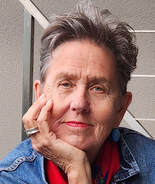Something had already changed at the dark end of Bridge Street. A couple of retailers chalked some hopscotch squares on the pavement and dawdled outside their shops to watch what might happen. People on the street responded almost immediately. An elderly woman with a Zimmer-frame was making slow progress up the street. She wasn't able to hop but she steered her frame towards the hopscotch markings so that she could at least walk over the numbered squares on the footpath.
 David Engwicht
David Engwicht We’ve all been to workshops with this kind of set-up: a worthy topic, presented by a dull but knowledgeable speaker, in a dull but functional room, aided and abetted by an over-head projector. If tears are shed at such workshops, they are usually tears of frustration. While work piles up back at the office, you squirm through the plodding torture of a PowerPoint presentation yearning for the impossibly distant El Dorado of morning tea.
But the tears that came to my eyes at this workshop were not those kind of tears. They were the kind of tears that come when something touches you deeply. The tears were also completely unexpected: when did you last feel moved by an interaction organised by a local authority?
The workshop, facilitated by David Engwicht, an Australian urban design expert, was about “home making” in all senses of the word. I think this is what I found so moving: public discourse rarely touches so explicitly and so candidly on the deepest of human longings.
Engwicht is sixty-three. His appearance is more aging rock star than corporate presenter. He fronted the workshop with mussed, pink-tipped grey hair, wearing pink-lensed glasses, tight black pants, groovy black shoes and a black jacket with the sleeves pushed up. He has no formal training in urban planning, but has established an international reputation as an innovative thinker (and doer) in the field.
As the son of an itinerant Queensland preacher, Engwicht had a peripatetic childhood and adolescence. The insight he gained from this early experience of living on the margins was a gift, and is one of the drivers behind his work. “Home is not a location”, he says, “it’s a feeling” and it’s possible to make everyone in a city “feel at home” by following a few simple principles.
Through Creative Communities International www.creative-communities.com the organisation he founded, Engwicht’s aims to:
• Inspire individuals, communities, organisations, and decision-makers to unlock their latent creative genius and to ‘think outside the box’.
• Empower individuals to take personal responsibility for fixing a broad range of community issues, including traffic and anti-social behaviour in public places.
• Encourage politicians, decision-makers, and city staff to stop fixing problems for the community by developing tools that empower the community to take civic responsibility.
Engwicht opened the morning session of the workshop with disarming frankness by sharing the fact that he’d recently attended couples counselling and then drew an analogy between what he’d learned there, and his work. He went on to talk us through low cost, people-centric ways it is possible to change “spaces into places” and “create vibrant neighbourhoods, prosperous shopping streets, and magical public spaces”.
In the afternoon, he walked with us around beleaguered Bridge Street and Buxton Square, pointing out the ways this area could be transformed. In doing so he challenged received notions about what makes a city feel like home – more security cameras, speed bumps and police certainly don’t - and posited a different kind of relationship between city councils and the communities.
The workshop was on Monday. By Tuesday something had already changed at the dark end of Bridge Street: a couple of retailers had put many of the Engwicht’s principles into play – literally - by chalking colourful hopscotch squares on the pavement and dawdling outside their shops to interact with passers-by. In so doing they had, in Engwicht’s terminology, psychologically reclaimed the street, created micro-intrigue and made themselves into street characters.
And, remarkably for Bridge Street, they had also created a sense of fun and theatre. People on the street responded almost immediately. I watched amazed, as an elderly woman with a Zimmer-frame changed her route past the shops so she could at least walk over the numbered squares on the footpath. More able-bodied folk actually hopped - one even asked for a stone so she could play the game properly.
Atstrid (from the Woodlea florist shop) and Christine (from Labels the designer clothing resale shop), chatted amiably with everyone who stopped to play or to watch what was happening. They had created what Engwicht had been talking about – an opportunity for people to connect positively with each other - with nothing more than some chutzpah and a few pieces of chalk.
Congratulations to Nelson City Council for its boldness in bringing David Engwicht to Nelson and thank you to Astrid and Christine for making the first move.
One small hop for Bridge Street: a giant leap for Nelson. Our home.
 RSS Feed
RSS Feed

